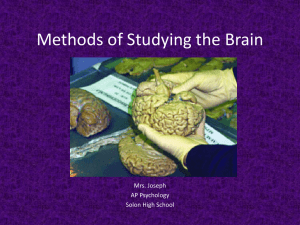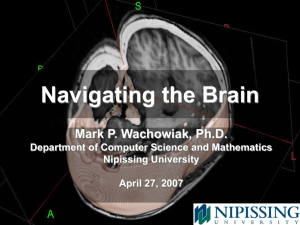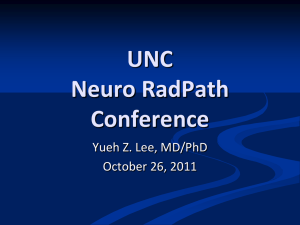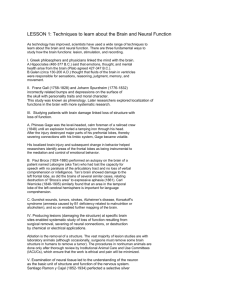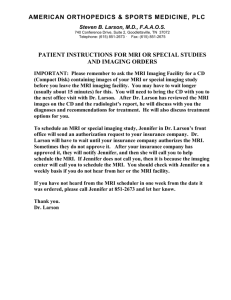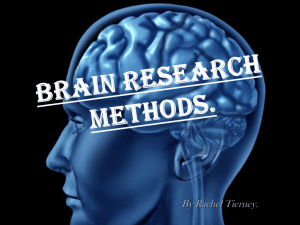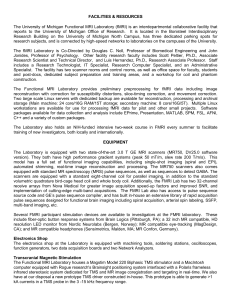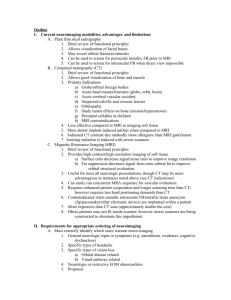Slides
advertisement
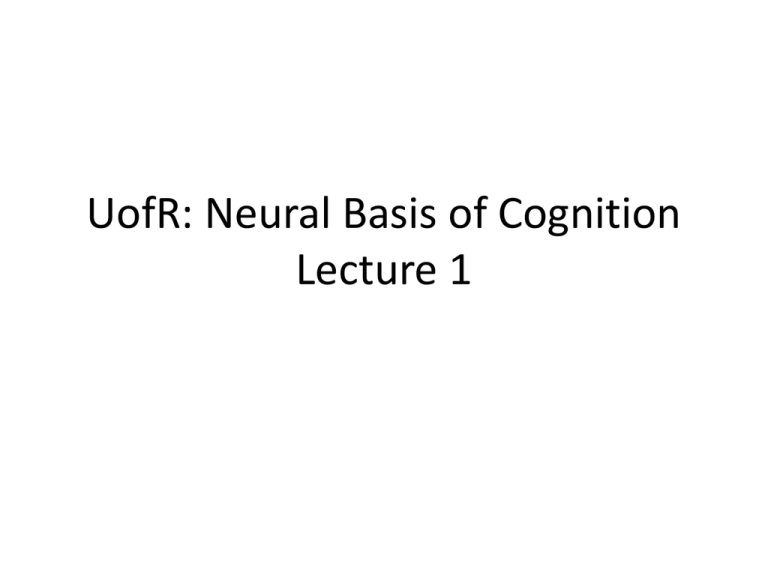
UofR: Neural Basis of Cognition Lecture 1 Neuroanatomy and Brain Function • What is the link? • Theory of Mass Action – posited that each portion of the brain contributed to all mental abilities – initially supported by the fact that increasing amounts of brain damage leads to increasing loss of mental ability – discredited only after more advanced tools and methods lead to the ability to demonstrate localization of function Neuroanatomy and Brain Function • Localization of Function – Particular mental functions can be localized to specific regions of brain tissue – Localization of function must be supplemented by communication between different parts of the brain in order to be able to produce the sum total of mental ability that is observed – Damage to one area of the brain may disrupt communication between other parts of the brain and cause deficits not all of which are in functions localized entirely to the site of damage. Lesion Method • Artificially induced lesions are extensively used in animal experiments and have led to a wealth of understanding. • Such experiments cannot be performed on humans. • Major advances in understanding of the human brain have been come from the study of people who sustained brain damage in some accident. Lesion Method • One may emphasize either knowledge about neural substrates… – Experimental group: a group of individuals whose brain damages are as similar as possible in location, extent, and, in some cases, cause • … or knowledge about cognitive function. – Experimental group: a group of individuals whose behavioral symptoms are as similar as possible. Double Dissociation • The sets of cognitive deficits produced by lesions in different areas are disjoint. • Classic example: – Broca’s area • Lesion impairs speech production • Speech comprehension is unimpaired – Wernicke’s area • Lesion impairs speech comprehension • Speech production is unimpaired Lesion Method • Difficulties: – The exact location and extent of a lesion are unlikely to be consistent across a group of human subjects. – the function of the lesioned area is not necessarily known – cognitive impairment may occur because a lesion disrupts communication between two still functional areas of the brain (disconnection syndrome) – an impairment in cognitive function may be “silent" if another part of the brain can perform the same tasks as the one lesioned Single, Group, Multiple-Case Studies • Single-case studies: – In-depth study of one patient – Gives only one data point • Group studies: – Individual variability can be hidden by averaging performance on a task • Multiple case studies: – Series of individuals with similar traumas are each individually extensively studied and then additionally analyzed as a group Experimental Considerations • Any experimental group must be compared to a control group. • The choice of a proper control group may be difficult as each subject in an experimental group must be matched with an individual of the control group with a similar background. • Consider: performance on a reasoning task is measured in a neurologically intact high school dropout as compared to a college-educated brain damaged individual Imaging Techniques • Anatomical imaging: – Computerized Axial Tomography (CAT) – Magnetic Resonance Imaging (MRI) • Functional imaging: – Positron Emission Tomography (PET) – Functional MRI (fMRI) Computerized Axial Tomography (CAT) • Technique: – Uses x-rays to differentiate between structures of different densities – Cerebrospinal fluid (CSF) is less dense than brain tissue, which is less dense than blood, which is less dense than bone – Denser matter appears lighter, less dense matter appears darker Computerized Axial Tomography (CAT) • Advantages: – Inexpensive – Widespread – Can be performed on all individuals • Disadvantages: – Relatively poor spatial resolution Magnetic Resonance Imaging (MRI) • Static field: aligns all particles’ magnetic moments in the same direction • Pulse sequence: frequency chosen so as to resonate with certain particles, perturbing their alignment (often adjusted for hydrogen atoms) – A perturbed hydrogen atom will release a photon as it falls back to an aligned state after an amount of time (relaxation time) characteristic of the compound in which it is located – The relaxation time can be used to infer the location of the type of compound to be localized Magnetic Resonance Imaging (MRI) • Advantages: – Higher spatial resolution than CAT – Avoids potentially harmful x-rays • Disadvantages: – Not every individual can be subjected to MRI (pacemakers, metal in the body) Positron Emission Tomography (PET) • Blood flow is higher in areas of higher neural activity • Radioactively labeled compounds are introduced into the bloodstream and thus the brain • Isotope decays by positron emission; positron annihilates with electron, emitting two photos in opposite directions Positron Emission Tomography (PET) • Advantages: – Can localize specific substances in the brain • H2O15: accumulates in brain in direct proportion to local blood flow, marking neural activity • Localizing dopamine receptors • Disadvantages: – Ionizing radiation – max 2-5 scans per year – Low temporal resolution due to isotope half-life • Advantages can much outweigh the disadvantages for some purposes Functional MRI (fMRI) • Increased brain function is associated with increased metabolism at the site of neural activity. • Increased metabolism involves the deoxygenation of blood; as blood contains iron, deoxygenation alters the sensitivity of blood to a magnetic field. • fMRI is an adaptation of MRI that is attuned to measure the relative concentrations of oxygenated versus deoxygenated blood on the scale of seconds and is used to accurately determine sites of increased brain function on a time scale that is shorter than that allowed by PET. Functional MRI (fMRI) • Advantages: – High spatial and temporal resolution – No use of ionizing radiation – Allows tracking of changes in a patient’s brain function over time due to no usage limits • Disadvantages: – Same as MRI

